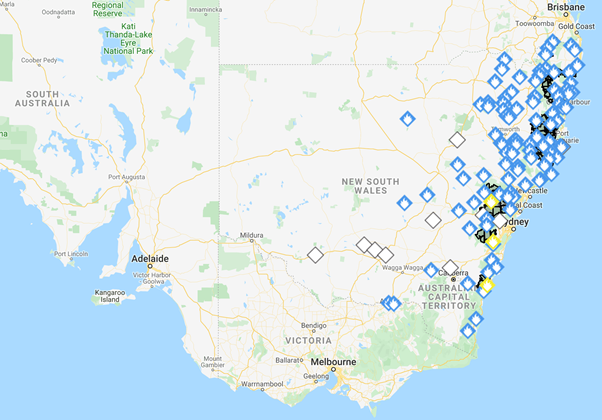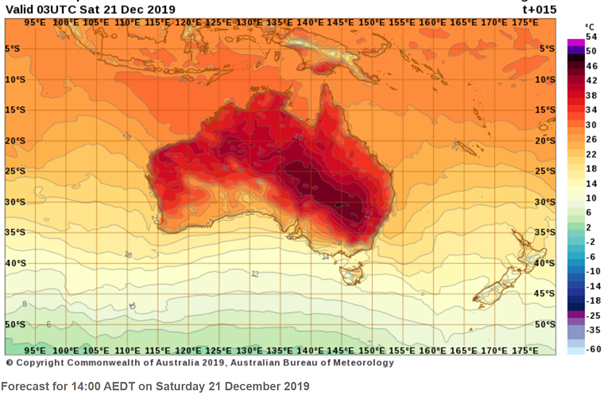The Climate Crisis, so straightforward in theory, becomes truly frightening when you encounter it in reality. Inside an aeroplane, SUV, or shopping centre it seems very distant, if non-existent. Get out in the real world and you do not have to look far.
Steve Keen is Distinguished Research Fellow, Institute for Strategy, Resilience & Security (ISRS) at UCL
Cross-posted from Steve Keen’s Website Rebuiliding Macroeconomics

I have to admit that I am personally not coping well with Climate Change. Five factors are pushing me towards feelings of depression:
- The same generalized anxiety about the future felt by Greta Thunberg and the the young people she’s inspired to strike for the climate;
- The special knowledge I have, from reading the work of Nordhaus and his cabal of climate-change-trivializing fellow Neoclassical economists, that the economic predictions of damages from climate change are dangerously misleading garbage.
- Since policymakers take what economists predict seriously (even after the 2008 financial crisis), they have been duped, and have drastically underestimated how severe climate change will actually be. No-one can know how bad it will be until it happens, of course. But given how dodgy and effectively fraudulent the work of Nordhaus and friends have been, it can only be far worse than they expect;
- Consequently, humanity’s policy response to climate change has been pathetically inadequate, and we will at some stage be forced to go from meaningless gestures and failures like COP 25 to belated and panicked attempts to avert catastrophe.
- The fact that I am Australian. The prediction from climate models that Australia would become significantly drier as temperatures rose is being born out very suddenly by enormous increases in the country’s average maximum temperature. The maximum average—across an entire continent—was 41.9° (107.5°F) C on Thursday, breaking the previous record of 40.9°C set the day before, which itself broke the previous record set in 2013 by about 0.5°C or 1°F. Tomorrow might break even that record.
Figure 1: Australia’s average maximum temperature was 41.9°C (107.5°F) on December 18 2019

- The unprecedented fire season in Australia. Most popular and professional attention about climate change has focused on the sea level rise impacts of climate change, but maybe the more immediate impact will be the transformation of areas that once supported forests into either grasslands or deserts.
- That transformation will by driven by fire, and maybe that’s what we’re seeing unfold in Australia right now. I don’t and can’t know whether that’s actually the case, but these fires are beyond anything I’ve ever experienced.
- I’ve lived through several major bushfire episodes around Sydney, including the famous fires from 1994 which destroyed over 100 homes in Sydney itself; and a fire in the late 1970s or early 1980s, during which I remember seeing flames from when on a train between suburban Hurstville and the city centre. Even though no homes have yet been lost in Sydney itself, the current fires across the country have burnt more than four times as many hectares already as in 1994, and the official fire season still has almost six months to run.
Figure 2: Fires map for NSW only at 4pm on Friday December 20th 2019. 111 fires active

- The horrific fires that surround Sydney right now, which make me scared for my friends and family there. There are 112 burning in NSW as I write this (at 6.55pm London time, which is 5.55am in NSW). Two groups of fires to the northwest and southwest of Sydney have merged into megafires covering more than 10,000 square kilometres, almost the area of Sydney itself. Both are licking at the edges of Sydney proper.
- All but four family units from my extended family live in Sydney (mother, sisters & spouses, nieces, nephews and their children). Only three of those—my 94-year-old mother, and two of my four sisters) live in regions that I can be confident won’t be directly affected by these fires.
- Two sisters’ houses are either in bushland (near a Northern NSW town called MacLean) or adjoining bushland in southern Sydney. One niece’s house (and possibly one nephew’s new house) is also dangerously close to bushland. A fire broke out about 3km from one sister’s house about four hours ago, though thankfully it’s since been put out.
- My real fear for my family is that the southwestern fire will jump the road between itself and the coast, at which point it could spread through the forests between Sydney and the southern satellite city of Wollongong, then into the Royal National Park, which abuts against “The Shire”. A sister, niece and nephew all have houses in that region. One literally faces a valley full of bush; another edges on to a similar forest; the third I haven’t yet seen, but it’s in a suburb full of bushland and heavily wooded streets.
Figure 3: Fires around Sydney. The northern group of fires is more than 7 times the size of Singapore

- The forecast for today is downright scary for the whole country. I just accessed it a couple of minutes ago, and as happens all too frequently right now, my instant reaction was “Oh Shit!!”. As well as the heat dome over the whole country, there are spots where the forecast is for temperatures in excess of 50°C. If they happen, that will be another record this year for December temperatures ever in Australia. It could even beat the all-time record local maximum of 50.7°C, set back in January 1960.
Figure 4: Current (12pm Friday Sydney time) for 2pm Sydney time today. Peak temperatures above 50°C

- But it’s not just the temperature that’s the worry: it’s the fires the temperature enables, by drying out the trees and making them not merely combustible but, as eucalypts, capable of exploding at low humidity levels and high temperature. Fires can jump kilometres ahead of their boundaries under these conditions, especially if winds come with the heat. Sydney is forecast to experience 60 km/hr winds later on today. That will drop temperatures by a good 10°C, but it could turbocharge the fires themselves.
Figure 5: Sydney forecast as of 5am Sydney time on December 20th.

I don’t want to sink into depression, but I can’t pretend that I’m not affected emotionally by these fires either. The only thing I can do is to turn what could become a debilitating depression into a more productive emotion—like anger.
I was angry enough when I first realised, on May 15, just how ludicrous the work of Nordhaus, Mendelsohn, Tol and friends was, via this crazy paragraph by Tol about using current temperature:GDP data to predict the impact of climate change:
Mendelsohn’s work …can be called the statistical approach. It is based on direct estimates of the welfare impacts, using observed variations (across space within a single country) in prices and expenditures to discern the effect of climate. Mendelsohn assumes that the observed variation of economic activity with climate over space holds over time as well; and uses climate models to estimate the future effect of climate change. (Tol 2009, p. 32)
Figure 6: My Twitter exchange with Tol, lead author of the economic impact component of the IPCC 2014 report

But that was just a generalized anger. Now, it has a personal component. My home city is under threat, as are members of my own family. Had humanity reacted to the warnings of the Limits to Growth study almost 50 years ago, none of this need have happened (Meadows, Randers et al. 1972). And who ensured that we didn’t listen? Economists, and most specifically Nordhaus with his “Measurement without Data” paper from 1973 (Nordhaus 1973).
My apologies for venting, but I felt that if I didn’t, depression could be the consequence. I prefer anger.
Postscript
Comments from Patrons reminded me of one point: if it turns out that fires, rather than rising sea levels, are the initial and incontrovertible symptom of Global Warming, then Australia may well go from being one of the planet’s leading deniers of climate change to one of its first victims. That will shift the political rhetoric significantly. At present, any attempt to get Australia to comply with international targets is met with “we’re only 1.3% of global emissions, so what we do has negligible effect”.
But what if Australia is the first serious victim? It’s already the world’s driest inhabited continent (only Antarctica gets less precipitation, but of course has far lower evaporation). Almost all climate change models predict Australia will get dryer thanks to global warming: rain that currently falls in its wheat belt will mainly migrate southwards, to fall in the ocean (Great Australian Bight) rather than on land. The desert continent’s deserts will start to encroach on its fertile regions, in a brutal process of fires and deafforestation. This quote is from Six Degrees: Our Future on a Hotter Planet, published ten years ago, in 2009:
In the three – degree world , far more of Australia will burn. Fire risk and intensity depends on the convergence of two key factors: drought and heat. Climate change projections show most of Australia getting hotter and drier over the century to come, seriously worsening fire risk. According to a major study published by CSIRO Atmospheric Research, days of high temperatures above 35 ° C could increase by 100 to 600 per cent ( 2 to 7 times ) in New South Wales by 2070. Truly searing days when the mercury rises beyond 40 ° C could increase sixfold in interior bush towns.
We’re not in a 3°C world yet–we’re about 1/3rd of the way there. But the trend starts from zero, and we’re already at 1°C.
If so, Australia’s political stance on climate change will flip completely. It will go from “we’re too small to make a difference” to “you’ve gotta stop emissions or we’ll burn to death”. I can see Pacific Island nations being less than impressed at Australia’s change of tune, when it comes, given how much Australia has disparaged their concerns about rising sea levels.


Be the first to comment